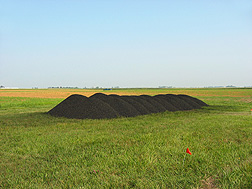
Bulk hardwood biochar prior to application on plots near Ames, Iowa.
(D2343-1)
When fires burned freely across the North American prairies, they left behind charred material that helped form the region’s dark, fertile soils. In South America, pre-Columbian Indians used slash-and-char practices to clear land for farming, which incorporated large amounts of char into the highly weathered soils of the Amazon. This char became a key building block in the development of the rich “terra preta”—or black earth—that sustained agriculture in the Amazon for more than 1,000 years.
Today, Agricultural Research Service scientists are learning more about “biochar,” the name for the charred biomass created from wood, plant material, and manure that has been used to improve soil fertility and remediate environmental contaminants. The multi-location effort is still under way, but preliminary results suggest that adding biochar to agricultural soils could rebuild soil fertility levels and improve nutrient and water retention. Biochar can even “sequester” carbon from plant materials by storing it underground, where it slowly decomposes and makes only a minimal contribution to the emission of the greenhouse gas carbon dioxide. So ARS scientists are working diligently—and carefully—to understand how biochar interacts with soil and crops so that the potential benefits observed in the laboratory can become economically viable realities in the field.
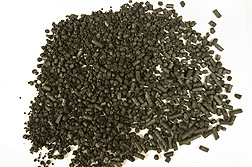
Biochar pellets in Prosser, Washington, made from dairy cow manure and used to capture phosphorus from dairy lagoons.(D2344-1)
First Steps
Much of the ARS field work on biochar started at the National Laboratory for Agriculture and the Environment (NLAE) in Ames, Iowa. During November 2007, NLAE scientists began the first of six multi-year field studies at ARS locations around the country to assess how biochar affects crop productivity and soil quality. NLAE scientists amended 24 plots (almost 8 acres) of corn with biochar made from hardwood biomass. Twelve plots had almost 8,800 pounds of biochar per acre, and 12 had almost 16,000 pounds per acre. But no significant difference was observed in the 3-year average grain yield from either treatment.
Other small-scale ARS field and laboratory studies in Idaho, Kentucky, Minnesota, South Carolina, and Texas showed that hardwood biochar could improve soil structure and increase the ability of sandy soils to retain water. But soil fertility response was more variable.
These results underscore what ARS scientists already knew: Biochar characteristics vary widely, depending on the feedstock used to make it, the time spent in the pyrolyzer—a device that uses heat to break down the biomass in the absence of oxygen—the temperature used during pyrolysis, the feedstock’s moisture content, and other factors. Because of structural differences, some biochars break down more quickly in soil than others. Biochars can also differ in particle size, porosity, surface area, pH, and biologically active and available compounds. So even though there’s already a lot of public enthusiasm about using biochar in agricultural production, ARS scientists are much more cautious about the possibilities.
ARS soil scientist Doug Karlen, who is the research leader of the ARS Soil, Water, and Air Resources Research Unit at NLAE, has been involved with the biochar studies from the outset. “Now we’re studying how crops respond to soils that have been amended with biochar made from corn stover,” he says. “We didn’t see a significant response when we amended an acre with 8 tons of biochar made from hardwood, so now we’re amending fields with as much as 50 tons of corn stover biochar per acre.”
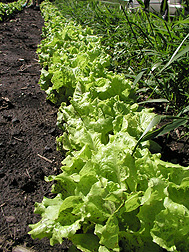
Lettuce growing in Minnesota field plots amended with 20,000 pounds of macadamia nut shell biochar per acre. The study evaluated how the biochar affects crop yield, soil fertility, and greenhouse gas production from the field.
(D2345-1)
Finding What Works Where
“We need to make sure that the biochar will actually improve the condition of the soil where it is being used,” says soil scientist Jeff Novak, who coordinates the ARS multi-location effort to learn more about biochar dynamics under different real-world field conditions. “We want to ensure that the correct biochar is applied to the right soil so that we avoid decreasing soil quality.”
Novak, who works at the ARS Coastal Plains Soil, Water, and Plant Research Center in Florence, South Carolina, is working with other scientists to manufacture “designer biochars” with properties tailored to remediate specific soil characteristics. He led a laboratory study to learn more about the characteristics of different biochars and to see which biochars could improve the sandy soils found on the Carolina coastal plain and the silt loam soils of the Pacific Northwest, which are derived from volcanic ash and windblown sediment known as “loess.”
Several other Florence researchers, including soil scientist Warren Busscher, environmental engineer Kyoung Ro, agricultural engineer Keri Cantrell, and microbiologist Tom Ducey, participated in the study. Other ARS partners included chemist Isabel Lima, who works in the ARS Commodity Utilization Research Unit in New Orleans, Louisiana; soil scientist Jim Ippolito, with the Northwest Irrigation and Soils Research Laboratory in Kimberly, Idaho; and ecologist Harry Schomberg at the J. Phil Campbell Sr. Natural Resource Conservation Center in Watkinsville, Georgia.
The team made biochars from peanut hulls, pecan shells, poultry litter, switchgrass, and hardwood waste products. By pyrolyzing these materials at different temperatures, the researchers produced nine different types of designer biochars. Then the biochars were mixed into one type of sandy soil and two silt loam soils at the rate of about 20 tons per acre. The test soils were leached with water every month.
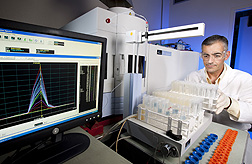
ARS soil scientist Jim Ippolito conducts analysis of essential plant elements from soils amended with biochar in Kimberly, Idaho.
(D2326-1)
After 4 months, the team found that biochars produced from switchgrass and hardwoods increased soil moisture storage in all three soils, but biochar made from the other biomass sources did not. They saw the greatest moisture increase in soils amended with switchgrass biochar produced via high-temperature pyrolysis—almost 3 to 6 percent higher than a control soil sample. Biochars produced at higher temperatures also decreased soil acidity, and biochar made from poultry litter greatly increased soil levels of available phosphorus and sodium.
Results also indicated that switchgrass biochar amendments could extend the window of soil water availability by 1.0 to 3.6 days for a soybean crop in Florence and could increase soil water availability for crops grown in Pacific Northwest silt loam soils by 0.4 to 2.5 days.
These results support hopes that agricultural producers might someday select feedstocks and pyrolysis processes to make designer biochars with characteristics that target deficiencies in specific soil types.
Karamat Sistani, research leader at the Animal Waste Management Research Unit in Bowling Green, Kentucky, is part of the ARS biochar team. “In 2010 we started a field study on combining biochar with poultry manure to see how microorganisms and nutrients in the manure affect biochar efficiency in improving soil quality and corn yield,” Sistani says. “We also want to see if it has any efficacy in mitigating greenhouse gas emissions of nitrous oxide, methane, and carbon dioxide.”
The Bowling Green researchers will also be determining whether biochar amendments can help improve the nutrient-holding capacity of Kentucky limestone karst soils, which develop large cracks that allow water and fertilizers to move quickly through the subsoil. In addition, Bowling Green hydrologist Carl Bolster and research associate Sergio Abit are conducting a lab study to see whether biochar affects the movement of pathogens like Escherichia coli in the soil.
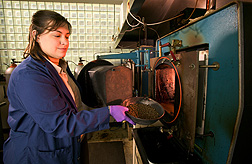
In New Orleans, technician Renee Bigner places poultry litter pellets into a furnace to make biochar via slow pyrolysis.
(D114-17)
The Results Aren’t All In Yet
In Kimberly, Idaho, Jim Ippolito and soil scientist Rick Lentz are studying how three different soil amendments—biochar, manure, or a biochar-manure combination—affect soil quality and crop response in the region’s calcareous soils. During the first study year, biochar-amended soils showed no real improvement in nutrient levels, aside from an increase in manganese, which is an essential plant nutrient, and a slight increase in total organic carbon. Soils amended with manure also had increased levels of manganese and of other plant nutrients.
“Both manure and biochar applied alone increased soil manganese, but their combined effect was synergistic,” Lentz says. “In plots where soil was amended with a biochar-manure mix, the total increase in manganese was greater than what we would have obtained from just adding the manganese increase from biochar to the manganese increase from manure.”
However, during 2010, fields amended with biochar had a 31-percent crop yield decrease, along with a 33-percent decrease in nitrogen uptake. Sulfur uptake in fields amended by biochar also decreased 7 percent.
“We think that the biochar is somehow inhibiting nitrogen and sulfur uptake, maybe by stabilizing the soil organic matter. This would reduce the mineralization rate of soil organic matter and decrease the availability of nitrogen and sulfur to the crop,” Lentz says. “After biochar is added to soil, its chemical and physical characteristics will change with time, so its effect on soils and crops may change accordingly.”
The third year of the study will help determine whether the 2010 results bear further investigation or were just a fluke. But the findings already demonstrate that biochar amendments might not always work the way farmers want them to work.
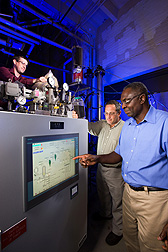
At Wyndmoor, Pennsylvania, chemical engineer Akwasi Boateng (right) and mechanical engineer Neil Goldberg (center) adjust pyrolysis conditions while chemist Charles Mullen loads the reactor with bioenergy feedstock.
(D1985-1)
Greenhouse Gas Emissions and Ethylene
In Minnesota, ARS scientists are studying biochar activity in soils formed from glacial deposits. Soil scientists Kurt Spokas and John Baker, who both work in the ARS Soil and Water Management Research Unit in St. Paul, found that amending glacial soils with biochar made from macadamia nut shells reduced a range of greenhouse gas emissions.
The scientists conducted laboratory incubation studies by amending the glacial soils with biochar at levels from 2 to 60 percent. They found that emission levels of carbon dioxide and nitrous oxide were suppressed by all amendment levels, but the nitrous oxide suppression was notable only in soils amended with 20, 40, or 60 percent biochar. The amended soils also had lower microbial production of carbon dioxide and lower volatilization rates for the pesticides atrazine and acetochlor.
“Now we’re looking at how volatile organic compounds, or VOCs, in biochar affect soil microbe activity,” says Spokas. “Since biochar is a product of thermal-chemical conversion, it has the same VOCs that we find in smoke and soot, like benzene and toluene. We’ve already identified 200 different VOCs in some biochars, which is significant, because we want to use clean biochar for agricultural production.”
Spokas and Baker also conducted the first study that documented the formation of ethylene—a key plant hormone that helps regulate growth—from biochar and soils amended with it. They found that ethylene production in biochar-amended non-sterile soil was double the level observed in biochar-amended sterile soil. This strongly suggests that soil microbes are active in this biochar-induced ethylene production and that the ethylene might be involved in plants’ reaction to biochar additions, since even low ethylene concentrations produce various plant responses.
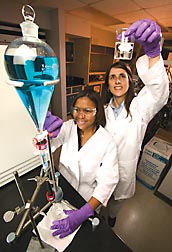
A column filled with poultry litter-based activated chars is put to the test by chemist Isabel Lima (right) and Bonnie Dillon by letting a solution of copper ion pass through. The solution turns clear as the copper ions are absorbed by the activated chars.
(D112-45)
Cleaning Up With Biochar
ARS scientists have also spent years investigating the use of biochar for environmental remediation. Retired ARS chemist Wayne Marshall, who worked at the ARS Southern Regional Research Center in New Orleans, Louisiana, started pursuing this line of research in the 1990s. He and Lima found that charred poultry litter is especially adept at removing hard-to-capture heavy metals like copper, cadmium, and zinc from wastewater. They produced pellets, granules, and powders made from the char for use in water tanks, columns, and other filtering structures.
The New Orleans scientists also developed a method for making carbons that have increased surface area for adsorption or chemical reactions. They did this by pelletizing ground poultry litter and then heating the pellets at high temperatures via slow pyrolysis to produce steam-activated char. ARS was issued two patents on the process, which Lima says could be used to replace traditional activated carbon adsorbents in air or liquid-waste cleanup applications.
Since 2006, chemical engineer Akwasi Boateng, who works at the ARS Sustainable Biofuels and Co-Products Research Unit in Wyndmoor, Pennsylvania, has helped lead ARS studies of biochar production via fast pyrolysis. Other Wyndmoor scientists contributing to these projects include research leader Kevin Hicks, chemist Charles Mullen, and mechanical engineer Neil Goldberg.
“We use fast pyrolysis when we produce bio-oil from biofeedstock to maximize fuel production, but this process produces a biochar byproduct that has a lower surface area,” says Boateng. “We’d like to improve the biofuel production process so that it also yields biochar that has a high surface area. This would make it more structurally suited to use as an activated charcoal and as a soil amendment. Identifying this kind of process could help make the biochar use in soils economical.”
As part of this effort, Boateng and Lima worked with other scientists in Wyndmoor and New Orleans to see whether steam activation would increase the ability of fast-pyrolysis biochars to adsorb toxic metals. They found that biochars made from broiler litter and alfalfa stems had the highest pollutant-uptake levels.
ARS microbiologist Hal Collins, who works at the Vegetable and Forage Crop Research Unit in Prosser, Washington, is exploring similar territory by evaluating the production of bio-oil and biochar from waste materials like wheat straw, logging debris, and manure. “There are a lot of concentrated animal-production facilities in the Pacific Northwest, and there’s not a lot of room available to store manure,” says Collins. “Nutrient runoff from these sites can potentially pollute nearby water sources, so using the manure to produce bio-oil and biochar could be one mechanism for controlling nutrients at dairy facilities.”
In one test, Collins made biochar from plant fibers remaining after processing dairy manure through an anaerobic digester used to capture methane from manure. He used that biochar to adsorb phosphorus present in the digester effluent. He found that the biochar removed 32 percent of the phosphorus from the effluent, and when the biochar was used as fertilizer, 13 percent of the adsorbed phosphorus was immediately available for plant uptake.
Given these results, Collins believes that bio-chars could help mitigate nutrient runoff but agrees that much more work is needed on the potential benefits and drawbacks. “Using this biochar to fertilize fields is not like using phosphorus fertilizer,” he says. “We can add 200 pounds of fertilizer per acre to support plant growth, but we’d need to add 2 to 3 tons of the biochar to add the same amount of phosphorus to the soil.”
Looking to the Literature
Spokas, Novak, and others conducted a meta-analysis of approximately 100 biochar studies and concluded that because of variability in char quality and application, results were about 25 percent negative, around 50 percent neutral, and around 25 percent positive. They published their findings in the Journal of Environmental Quality.
“A lot of research has already been done on biochar,” says Spokas, who is the first author on the paper. “We’re building on that work to figure out how to make biochar work best in our current production systems.”
Novak, who is working with Ippolito and Spokas on additional experiments in the laboratory and field, agrees. “We just need to make sure it’s the right biochar for the right soil type,” he says.
“We’re still trying to get our hands around this,” Karlen concurs. “We’re very curious. But we don’t have all the answers yet.”—By Ann Perry, Agricultural Research Service Information Staff.
This research is part of Climate Change, Soils, and Emissions (#212) and Water Availability and Watershed Management (#211), two ARS national programs described at www.nps.ars.usda.gov.
To reach scientists mentioned in this story, contact Ann Perry, USDA-ARS Information Staff, 5601 Sunnyside Ave., Beltsville, MD 20705-5129; (301) 504-1628.
"Carefully Unraveling the Intricacies of Biochar" was published in theNovember/December 2011 issue of Agricultural Research magazine.




No comments:
Post a Comment